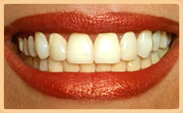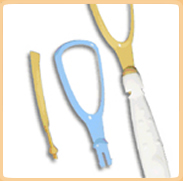
Are you happy with your smile? | Are you suffering from sensitive teeth? | At what age should I bring my child to the dentist for their first visit? | What is periodontal disease?
What is Halitosis? | Do I need a mouthguard?
What is Halitosis? | Do I need a mouthguard?
Are you happy with your smile?
 Are you happy with your smile? Sometimes the only difference between a nice smile and a beautiful smile is the whiteness of the teeth. Teeth naturally darken a bit over the years and lose some brightness because they accumulate stains from foods and beverages. Years of exposure to cola, coffee, tea, red wine, and smoking stain teeth and make them appear dull. There are several safe and effective options available to brighten your smile without harming your teeth. By far the fastest and safest whitening options are offered by your dentist. The most popular choice is an at-home bleaching procedure. This requires a dental visit, where you'll be fitted for a customized bleaching tray to hold the whitening gel against your teeth. Before any bleaching is performed the dentist will do an exam to ensure that your gums are healthy and your teeth are cavity free. While you can get over-the-counter whitening kits, they usually aren't as effective as professional whitening procedures. Because the over-the-counter trays are not custom fitted, the whitening agent may leak out and irritate your gums. Want a beautiful smile? Ask your dentist about dental whitening.
Are you happy with your smile? Sometimes the only difference between a nice smile and a beautiful smile is the whiteness of the teeth. Teeth naturally darken a bit over the years and lose some brightness because they accumulate stains from foods and beverages. Years of exposure to cola, coffee, tea, red wine, and smoking stain teeth and make them appear dull. There are several safe and effective options available to brighten your smile without harming your teeth. By far the fastest and safest whitening options are offered by your dentist. The most popular choice is an at-home bleaching procedure. This requires a dental visit, where you'll be fitted for a customized bleaching tray to hold the whitening gel against your teeth. Before any bleaching is performed the dentist will do an exam to ensure that your gums are healthy and your teeth are cavity free. While you can get over-the-counter whitening kits, they usually aren't as effective as professional whitening procedures. Because the over-the-counter trays are not custom fitted, the whitening agent may leak out and irritate your gums. Want a beautiful smile? Ask your dentist about dental whitening.
Are you suffering from sensitive teeth?
Do you find yourself wincing after drinking a hot or cold beverage? Is brushing and flossing your teeth a painful ordeal? You may be suffering from a very common condition called "dentin hypersensitivity" also know as sensitive teeth. The source of your pain lies in the exposure of the inner layer of the teeth known as dentin. This may either be due to the wearing of the protective coating around the teeth know as enamel or from the recession of your gums which in turn, exposes the roots of your teeth. The roots of teeth lack the hard protective layer of enamel, the hardest substance in the human body, thereby exposing the underlying dentin layer. Frequent causes are excess pressure when brushing or flossing, worn down, cracked or chipped teeth and more seriously, cavities or periodontal diseases.Rest assured, with the help of your dentist, several solutions exists. Depending on your diagnosis, your dentist may suggest a desensitizing gel or toothpaste to help with the discomfort. These products contain agents that are effective in blocking channels that connect to your nerves. Another solution can be a fluoride gel, this helps strengthen the dentin therefore making it less porous. The placement of a "bonding agent" or coating over the exposed areas may also be of help. In some cases a filling may be required whereas in other more advanced cases of gum recession a gum graft may be the answer. The good news is that this condition can often be easily avoided by simply learning how to correctly brush your teeth with the help of a soft or ultra soft bristle toothbrush. Feel free to talk to your dentist about which solution would work best for you.
At what age should I bring my child to the dentist for their first visit?
 Ideally your child should have their first dental appointment by their first birthday. The Canadian Dental Association recommends that your child has their first dental visit within 6 months of the eruption of the first tooth or by one year of age. During this first visit a comprehensive review of your child's medical history and a complete oral evaluation will be done. This will identify any special risk factors that may compromise your child's oral health. Risk factors such as their general health, the presence of tooth defects and developmental anomalies in their teeth, feeding patterns and diet, oral hygiene practices and fluoride availability can be identified very early and appropriate management strategies can be recommended for your child's specific needs. In addition your dentist may want to take radiographs or x-rays of your child's teeth at the first visit. Radiographs help detect cavities between the teeth and also help assess if teeth are developing properly and are coming in at the appropriate time. It is very important that your child's first visit be a pleasant one, so don't wait until a problem or an emergency develops. When preparing your child for their first visit don't use negative phrases like "It won't hurt much" or "It won't be too bad". Such phrases do not reassure but they only create anxiety. A healthy mouth is a happy mouth, so it is essential to get an early start on proper dental care practices at home. Begin by cleaning your child's mouth with a soft wet infant wash cloth even before any teeth come in and continue with a soft toothbrush once the first tooth appears. Try to promote healthy food choices from the very beginning and limit the number of sugary treats you give your child. It is important to get an early start on good dental habits, so that your child will learn that visiting the dentist is an essential part of good health care.
Ideally your child should have their first dental appointment by their first birthday. The Canadian Dental Association recommends that your child has their first dental visit within 6 months of the eruption of the first tooth or by one year of age. During this first visit a comprehensive review of your child's medical history and a complete oral evaluation will be done. This will identify any special risk factors that may compromise your child's oral health. Risk factors such as their general health, the presence of tooth defects and developmental anomalies in their teeth, feeding patterns and diet, oral hygiene practices and fluoride availability can be identified very early and appropriate management strategies can be recommended for your child's specific needs. In addition your dentist may want to take radiographs or x-rays of your child's teeth at the first visit. Radiographs help detect cavities between the teeth and also help assess if teeth are developing properly and are coming in at the appropriate time. It is very important that your child's first visit be a pleasant one, so don't wait until a problem or an emergency develops. When preparing your child for their first visit don't use negative phrases like "It won't hurt much" or "It won't be too bad". Such phrases do not reassure but they only create anxiety. A healthy mouth is a happy mouth, so it is essential to get an early start on proper dental care practices at home. Begin by cleaning your child's mouth with a soft wet infant wash cloth even before any teeth come in and continue with a soft toothbrush once the first tooth appears. Try to promote healthy food choices from the very beginning and limit the number of sugary treats you give your child. It is important to get an early start on good dental habits, so that your child will learn that visiting the dentist is an essential part of good health care.
What is periodontal disease?
 Periodontal disease, or gum disease, is a serious infection of the tissue that supports your teeth. Periodontal disease is divided into two main categories; gingivitis which affects only the gum tissue, and periodontitis which affects both the gum tissue and the bone.
Periodontal disease, or gum disease, is a serious infection of the tissue that supports your teeth. Periodontal disease is divided into two main categories; gingivitis which affects only the gum tissue, and periodontitis which affects both the gum tissue and the bone.Even in the cleanest mouth as many as 100,000 bacteria can be present on each tooth surface, but when plaque is present, as many as 1 billion bacteria may be growing on each tooth. Have a look inside your mouth the next time you brush your teeth.
The bacteria in your mouth form a sticky film on your teeth that over time results in the build up of plaque and tartar. With time, plaque can spread and advance below the gum line. The bacteria in the plaque produce toxins which not only irritate the gums but affect the bone that supports your teeth resulting in the formation of pockets. As the disease progresses, the pockets deepen and more gum tissue and bone are destroyed. Left untreated this process can result in teeth becoming loose and having to be extracted.
The bacteria in the plaque impact more than just your teeth. Studies are finding links between periodontal disease and systemic diseases such as heart attack, stroke, and diabetes. There are also several stages and severities of periodontal disease each requiring a unique treatment approach to manage the disease. Due to the complex nature of this disease, a customized treatment regimen can be tailored to your specific needs. Ask your dentist about periodontal disease the next time you're in for a check up.
What is Halitosis?
 Halitosis is an oral health condition characterized by consistently odorous breath and is said to affect more than 90 million people. There are many different factors which may cause bad breath.
Halitosis is an oral health condition characterized by consistently odorous breath and is said to affect more than 90 million people. There are many different factors which may cause bad breath.
Xerostomia (dry mouth) is a major cause of bad breath because the mouth is unable to cleanse itself or remove debris due to a decrease in saliva production which may be a result of certain medications, a salivary gland disorder or mouth breathing. Lack of brushing or flossing can result in particles of food remaining in the mouth which in turn causes bad breath. Other potential causes are periodontal or gum disease, use of tobacco products, and improper cleaning of dentures. Some medical conditions including postnasal drip, sinusitis, bronchitis, diabetes, gastrointestinal disturbance and kidney or liver ailments can also cause halitosis.
To avoid chronic bad breath, remember that it is important to practice good oral hygiene at home by properly brushing and flossing your teeth and thoroughly cleaning removable appliances such as nightguards before placing them back in your mouth. Don't forget to clean your tongue with a toothbrush or a tongue scraper to remove odour causing bacteria. Your dentist can help you determine the cause of your bad breath and recommend a professional dental cleaning to remove the plaque and tartar that accumulates around the teeth and under the gums or he may prescribe an antimicrobial rinse or recommend a specific mouthwash.
Do I need a mouthguard?
 It is recommended that anyone who participates in a sport which carries a risk of injury wear a mouthguard. These include but are not limited to football, hockey, basketball, soccer, baseball, and even gymnastics.
It is recommended that anyone who participates in a sport which carries a risk of injury wear a mouthguard. These include but are not limited to football, hockey, basketball, soccer, baseball, and even gymnastics.A properly fitted mouthguard is an important piece of athletic gear which can help protect your smile. They typically cover the upper teeth and help to cushion a blow to the face minimizing the risk of broken teeth and injuries to the lips, tongue, face or jaw. It's believed that they also may reduce the severity and incidence of concussions.
There are three types of mouthguards currently available. The first type is the stock mouthguard which comes pre-formed and ready to wear. These are the least desirable as they often don't fit very well and can be very bulky. The second type, boil and bite mouthguard is purchased ready-made, boiled and then moulded to the teeth. Although these are slightly better fitting, bulkiness and uneven distribution of material can prevent proper comfort, fit and protection. The third type of mouthguard is the custom made mouthguard. These are made by your dentist for you personally and offer a better fit and therefore better protection than anything you can buy off the shelf.
When considering which type to buy, remember that only a properly fitting mouthguard can offer the best protection.




